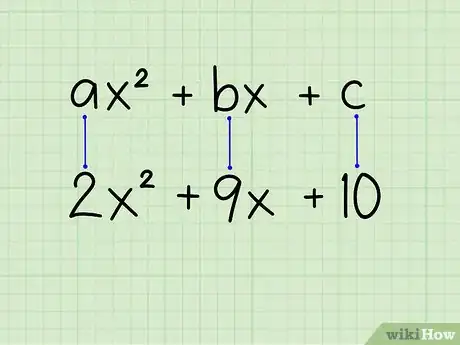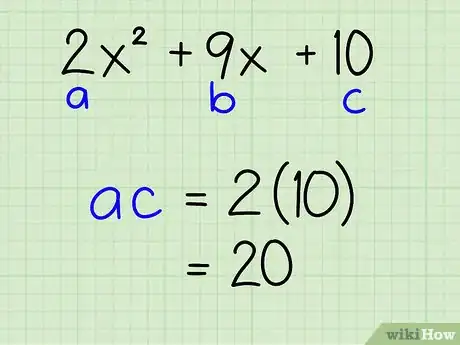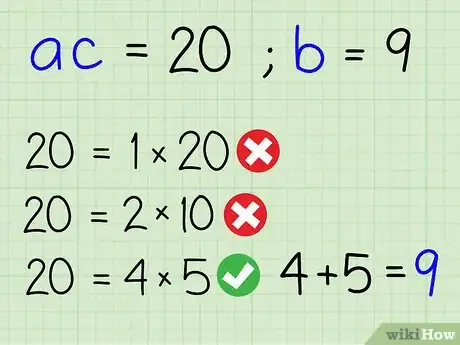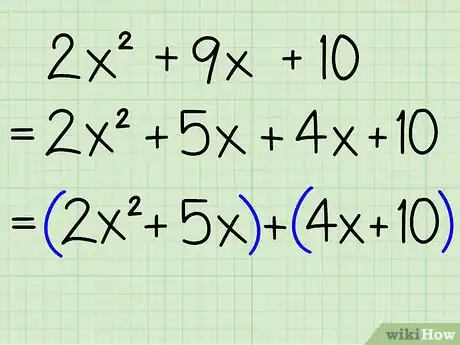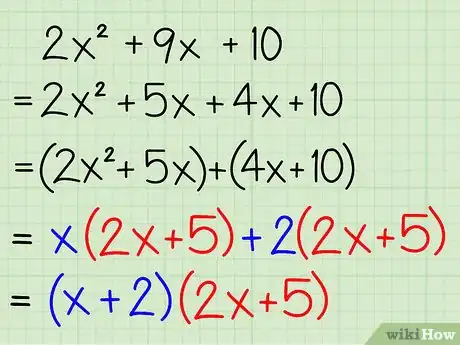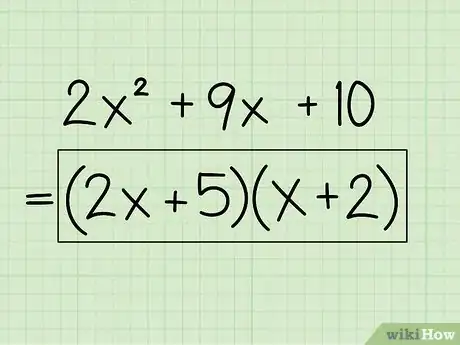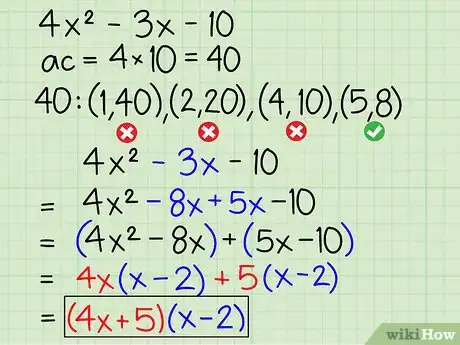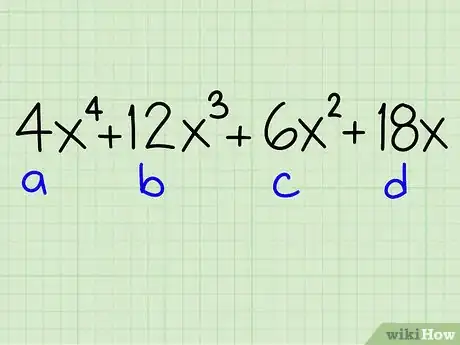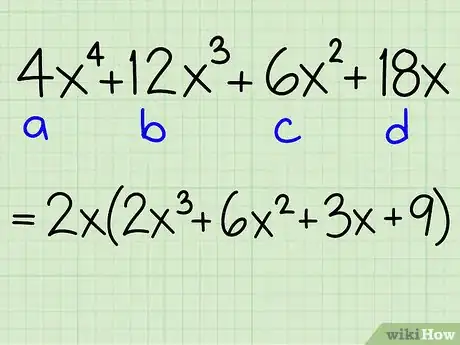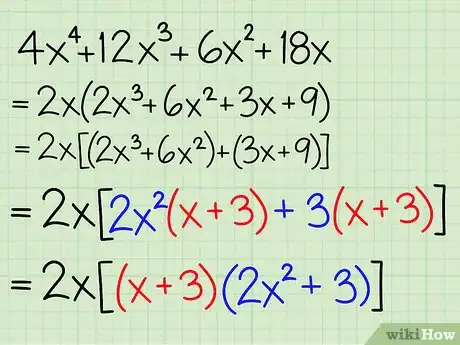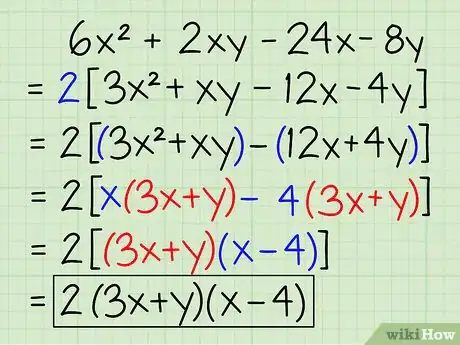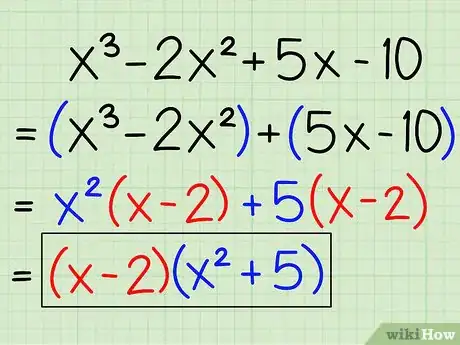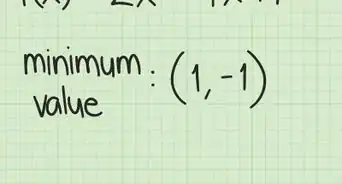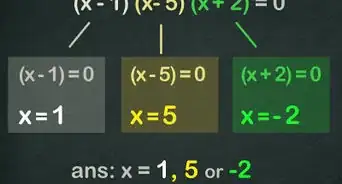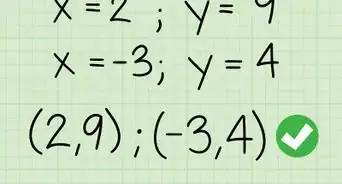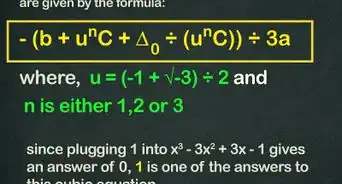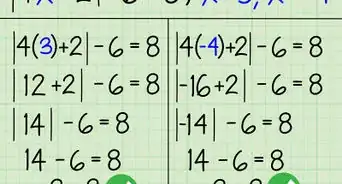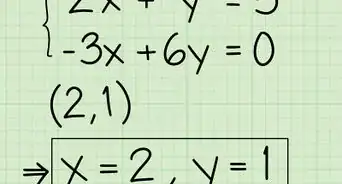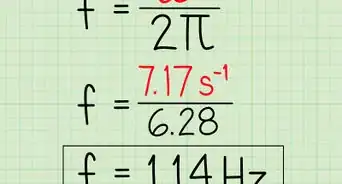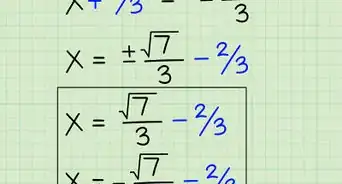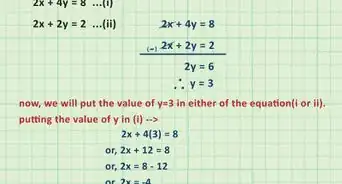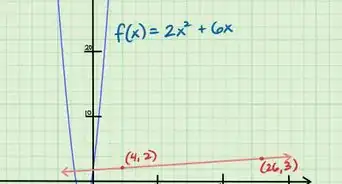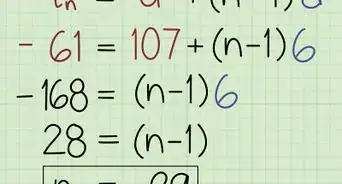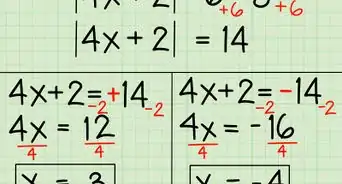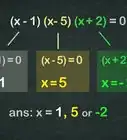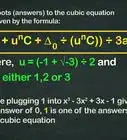This article was co-authored by David Jia. David Jia is an Academic Tutor and the Founder of LA Math Tutoring, a private tutoring company based in Los Angeles, California. With over 10 years of teaching experience, David works with students of all ages and grades in various subjects, as well as college admissions counseling and test preparation for the SAT, ACT, ISEE, and more. After attaining a perfect 800 math score and a 690 English score on the SAT, David was awarded the Dickinson Scholarship from the University of Miami, where he graduated with a Bachelor’s degree in Business Administration. Additionally, David has worked as an instructor for online videos for textbook companies such as Larson Texts, Big Ideas Learning, and Big Ideas Math.
This article has been viewed 106,759 times.
Grouping is a specific technique used to factor polynomial equations. You can use it with quadratic equations and polynomials that have four terms. The two methods are similar, but do vary slightly.
Steps
Quadratic Equations
-
1Look at the equation. If you plan to use this method, the equation should follow a basic format of: ax2 + bx + c.[1]
- This process is usually used when the leading coefficient (the a term) is a number other than "1," but it can also be used for quadratic equations in which a = 1.
- Example: 2x2 + 9x + 10
-
2Find the master product. Multiply the a term and c term together. The product of these two terms is referred to as the master product.[2]
-
Example: 2x2 + 9x + 10
- a = 2; c = 10
- a * c = 2 * 10 = 20
Advertisement -
Example: 2x2 + 9x + 10
-
3Separate the master product into its factor pairs. List the factors of your master product, separating them into their natural pairs (the pairs required to produced the master product).
-
Example: The factors of 20 are: 1, 2, 4, 5, 10, 20
- Written in factor pairs: (1, 20), (2, 10), (4, 5)
-
Example: The factors of 20 are: 1, 2, 4, 5, 10, 20
-
4Find a factor pair with a sum equal to b. Look through the factor pairs and determine which set will produce the b term—the middle term and the coefficient of x—when added together.[3]
- If your master product was negative, you will need to find a pair of factors that equal the b term when subtracted from one another.
-
Example: 2x2 + 9x + 10
- b = 9
- 1 + 20 = 21; this is not the correct pair
- 2 + 10 = 12; this is not the correct pair
- 4 + 5 = 9; this is the correct pair
-
5Split the center term into the two factors. Rewrite the center term, breaking it apart into the factor pair previously identified. Make sure that you include the proper signs (plus or minus).[4]
- Note that the order of the center terms should not matter for this problem. No matter which order you write the terms in, the end result should be the same.
- Example: 2x2 + 9x + 10 = 2x2 + 5x + 4x + 10
-
6Group the terms to form pairs. Group the first two terms into a pair and the second two terms into a pair.[5]
- Example: 2x2 + 5x + 4x + 10 = (2x2 + 5x) + (4x + 10)
-
7Factor out each pair. Find the common factors of the pair and factor them out. Rewrite the equation accordingly.[6]
- Example: x(2x + 5) + 2(2x + 5)
-
8Factor out shared parentheses. There should be a shared binomial parentheses between the two halves. Factor this out, and place the other terms in another parentheses.[7]
- Example: (2x + 5)(x + 2)
-
9Write your answer. You should now have your final answer.[8]
-
Example: 2x2 + 9x + 10 = (2x + 5)(x + 2)
- The final answer is: (2x + 5)(x + 2)
-
Example: 2x2 + 9x + 10 = (2x + 5)(x + 2)
Additional Examples
-
1Factor: 4x2 - 3x - 10
- a * c = 4 * -10 = -40
- Factors of 40: (1, 40), (2, 20), (4, 10), (5, 8)
- Correct factor pair: (5, 8); 5 - 8 = -3
- 4x2 - 8x + 5x - 10
- (4x2 - 8x) + (5x - 10)
- 4x(x - 2) + 5(x - 2)
- (x - 2)(4x + 5)
-
2Factor: 8x2 + 2x - 3
- a * c = 8 * -3 = -24
- Factors of 24: (1, 24), (2, 12), (4, 6)
- Correct factor pair: (4, 6); 6 - 4 = 2
- 8x2 + 6x - 4x - 3
- (8x2 + 6x) - (4x + 3)
- 2x(4x + 3) - 1(4x + 3)
- (4x + 3)(2x - 1)
Polynomials with Four Terms
-
1Look at the equation. The equation should have four separate terms. The exact appearance of those four terms can vary, however.
- Usually, you will use this method when you see a polynomial equation that looks like: ax3 + bx2 + cx + d
- The equation may also look like:
- axy + by + cx + d
- ax2 + bx + cxy + dy
- ax4 + bx3 + cx2 + dx
- Or similar variations.
- Example: 4x4 + 12x3 + 6x2 + 18x
-
2Factor out the greatest common factor (GCF). Determine if all four terms have anything in common. The greatest common factor among the four terms, if any common factors exist, should be factored out of the equation.[9]
- If the only thing all four terms has in common is the number "1," there is no GCF and nothing can be factored out at this point.
- When you do factor out a GCF, make sure that you continue to keep it at the front of your equation as you work. This factored out GCF must be included as part of your final answer for that answer to be accurate.
-
Example: 4x4 + 12x3 + 6x2 + 18x
- Each term has 2x in common, so the problem can be rewritten as:
- 2x(2x3 + 6x2 + 3x + 9)
-
3Create smaller groups within the problem. Group the first two terms together and the second two terms together.[10]
- If the first term of the second group has a minus sign in front of it, you will need to put a minus sign in front of the second parentheses. You will need to change the sign of the second term in that grouping to reflect that choice.
- Example: 2x(2x3 + 6x2 + 3x + 9) = 2x[(2x3 + 6x2) + (3x + 9)]
-
4Factor out the GCF from each binomial. Identify the GCF in each binomial pair and factor it to the outside of the pair. Rewrite the equation accordingly.[11]
- At this point, you might be faced with a choice between factoring out a positive number or a negative number for the second group. Look at the signs before the second and fourth terms.
- When the two signs are the same (both positive or both negative), factor out a positive number.
- When the two signs are different (one negative and one positive), factor out a negative number.
- Example: 2x[(2x3 + 6x2) + (3x + 9)] = 2x2[2x2(x + 3) + 3(x + 3)]
- At this point, you might be faced with a choice between factoring out a positive number or a negative number for the second group. Look at the signs before the second and fourth terms.
-
5Factor out the common binomial. The binomial pair inside both parentheses should be the same. Factor this out of the equation, then group the remaining terms into another parentheses set.[12]
- If the binomials inside the current sets of parentheses do not match, double-check your work or try rearranging your terms and grouping the equation again.
- The parentheses must match. If they do not match no matter what you try, the problem cannot be factored by grouping or by any other method.
- Example: 2x2[2x2(x + 3) + 3(x + 3)] = 2x2[(x + 3)(2x2 + 3)]
-
6Write your answer. You should have the final answer at this point.
-
Example: 4x4 + 12x3 + 6x2 + 18x = 2x2(x + 3)(2x2 + 3)
- The final answer is: 2x2(x + 3)(2x2 + 3)
-
Example: 4x4 + 12x3 + 6x2 + 18x = 2x2(x + 3)(2x2 + 3)
Additional Examples
-
1Factor: 6x2 + 2xy - 24x - 8y
- 2[3x2 + xy - 12x - 4y]
- 2[(3x2 + xy) - (12x + 4y)]
- 2[x(3x + y) - 4(3x + y)]
- 2[(3x + y)(x - 4)]
- 2(3x + y)(x – 4)
-
2Factor: x3 - 2x2 + 5x - 10
- (x3 - 2x2) + (5x - 10)
- x2(x - 2) + 5(x - 2)
- (x - 2)(x2 + 5)
-
3When factoring by grouping, after factoring out the GCF from each group, the binomials in the two sets of parentheses must match up in order to go any further with the problem.
Community Q&A
-
QuestionWhat is the factor of 3xy - zw + 3xw?
 DonaganTop AnswererAs a first-degree polynomial, that expression cannot be factored, because there is no letter or number common to all three terms.
DonaganTop AnswererAs a first-degree polynomial, that expression cannot be factored, because there is no letter or number common to all three terms.
References
- ↑ http://www.mathwarehouse.com/algebra/polynomial/how-to-factor-by-grouping.php
- ↑ http://www.mathwarehouse.com/algebra/polynomial/how-to-factor-by-grouping.php
- ↑ https://www.mathsisfun.com/algebra/factoring-quadratics.html
- ↑ https://www.purplemath.com/modules/simpfact3.htm
- ↑ https://www.purplemath.com/modules/simpfact3.htm
- ↑ https://www.mathsisfun.com/algebra/factoring-quadratics.html
- ↑ https://www.khanacademy.org/math/algebra/x2f8bb11595b61c86:quadratics-multiplying-factoring/x2f8bb11595b61c86:factor-quadratics-grouping/a/factoring-by-grouping
- ↑ https://www.khanacademy.org/math/algebra/x2f8bb11595b61c86:quadratics-multiplying-factoring/x2f8bb11595b61c86:factor-quadratics-grouping/a/factoring-by-grouping
- ↑ https://www.wtamu.edu/academic/anns/mps/math/mathlab/int_algebra/int_alg_tut27_gcf.htm
About This Article
To factor a quadratic equation by grouping, start by multiplying the "a" term by the "c" term to get the master product. Then, list all of the factors of your master product, and separate them into their natural pairs. Next, look for the factor pair that has a sum equal to the "b" term in the equation, and split the "b" term into 2 factors. Finally, group the terms to form pairs, factor out each pair, and factor out the shared parentheses. To learn how to factor polynomials by grouping, scroll down!
